A Comprehensive Report on Data Ownership in Computer Science Context
VerifiedAdded on 2021/12/10
|7
|1732
|73
Report
AI Summary
This report delves into the concept of data ownership within the realm of computer science, defining it as the legal rights and control over data assets. It explores the significance of data ownership in establishing clear responsibilities for data acquisition, usage, and distribution. The report discusses various data ownership models, including centralized and decentralized approaches, analyzing their respective benefits and drawbacks. It highlights the importance of data ownership policies in defining roles, responsibilities, and dispute resolution mechanisms. The report outlines the steps involved in creating effective data ownership policies, such as identifying stakeholders, cataloging data sets, and assigning roles. Furthermore, it emphasizes the need for maintaining an ownership registry to track policies and roles, ensuring ethical data management. The conclusion stresses the importance of a well-managed ownership registry, providing access to interested parties, and adapting to changes in data management structures to maintain data governance.
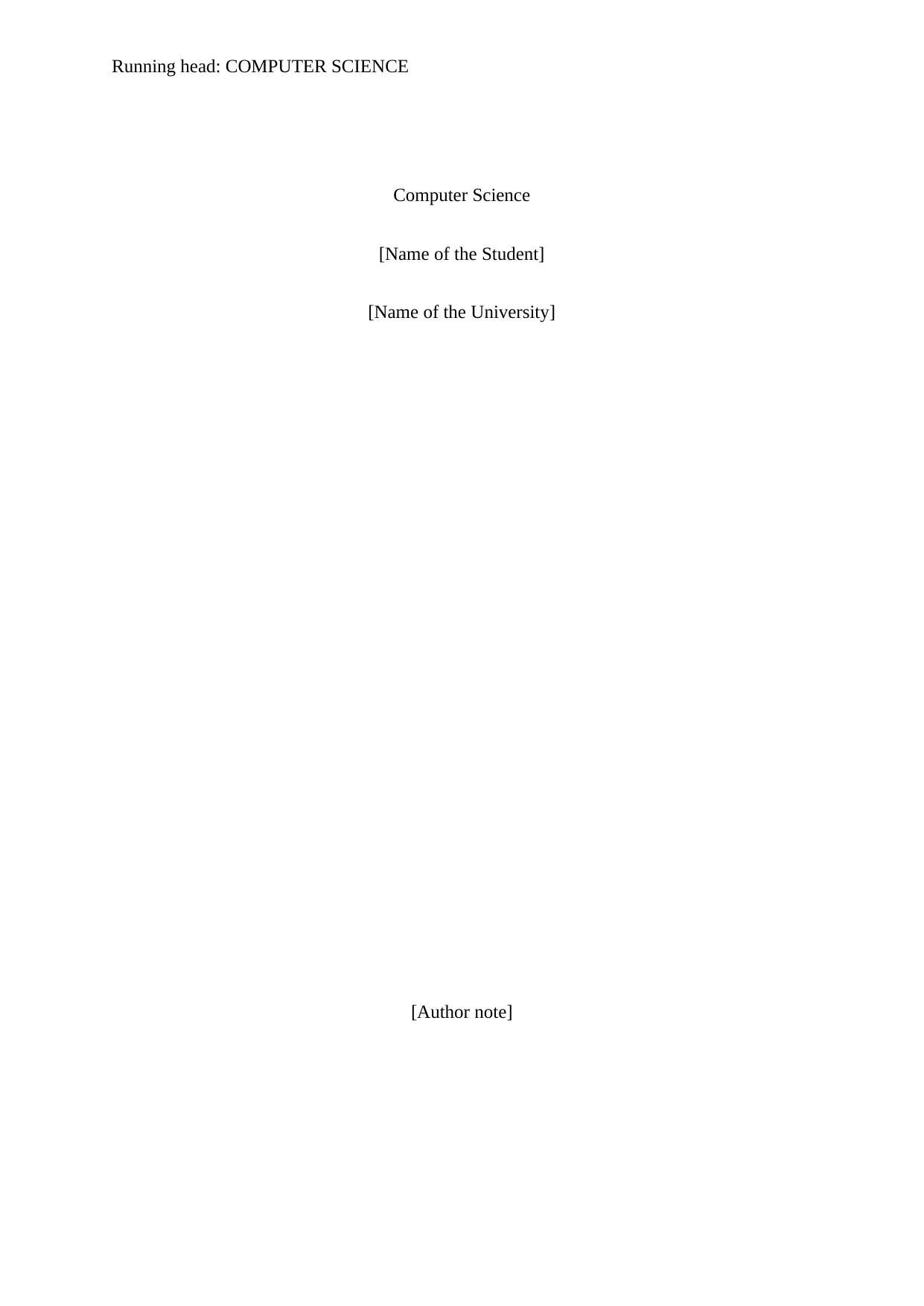
Running head: COMPUTER SCIENCE
Computer Science
[Name of the Student]
[Name of the University]
[Author note]
Computer Science
[Name of the Student]
[Name of the University]
[Author note]
Paraphrase This Document
Need a fresh take? Get an instant paraphrase of this document with our AI Paraphraser
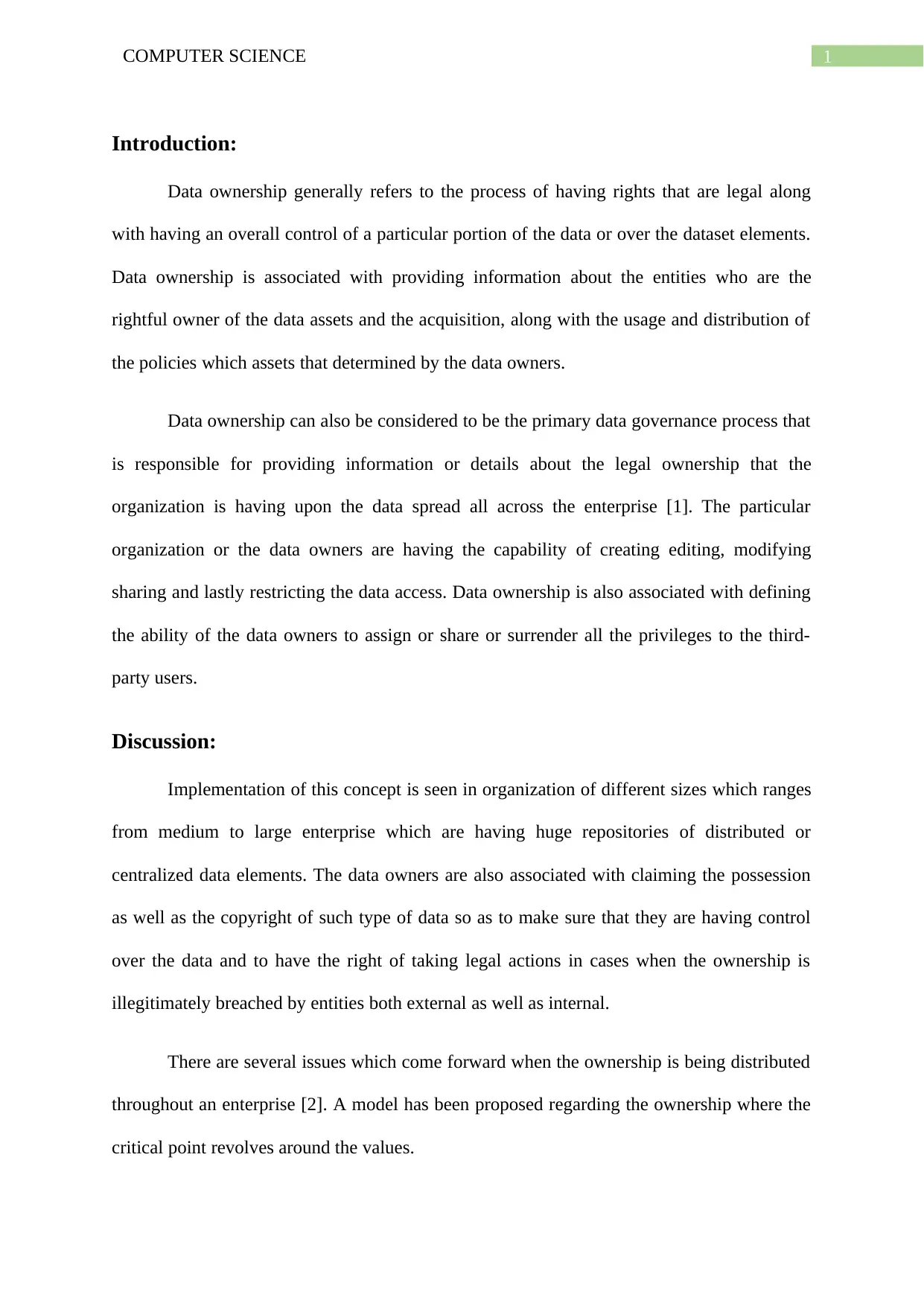
1COMPUTER SCIENCE
Introduction:
Data ownership generally refers to the process of having rights that are legal along
with having an overall control of a particular portion of the data or over the dataset elements.
Data ownership is associated with providing information about the entities who are the
rightful owner of the data assets and the acquisition, along with the usage and distribution of
the policies which assets that determined by the data owners.
Data ownership can also be considered to be the primary data governance process that
is responsible for providing information or details about the legal ownership that the
organization is having upon the data spread all across the enterprise [1]. The particular
organization or the data owners are having the capability of creating editing, modifying
sharing and lastly restricting the data access. Data ownership is also associated with defining
the ability of the data owners to assign or share or surrender all the privileges to the third-
party users.
Discussion:
Implementation of this concept is seen in organization of different sizes which ranges
from medium to large enterprise which are having huge repositories of distributed or
centralized data elements. The data owners are also associated with claiming the possession
as well as the copyright of such type of data so as to make sure that they are having control
over the data and to have the right of taking legal actions in cases when the ownership is
illegitimately breached by entities both external as well as internal.
There are several issues which come forward when the ownership is being distributed
throughout an enterprise [2]. A model has been proposed regarding the ownership where the
critical point revolves around the values.
Introduction:
Data ownership generally refers to the process of having rights that are legal along
with having an overall control of a particular portion of the data or over the dataset elements.
Data ownership is associated with providing information about the entities who are the
rightful owner of the data assets and the acquisition, along with the usage and distribution of
the policies which assets that determined by the data owners.
Data ownership can also be considered to be the primary data governance process that
is responsible for providing information or details about the legal ownership that the
organization is having upon the data spread all across the enterprise [1]. The particular
organization or the data owners are having the capability of creating editing, modifying
sharing and lastly restricting the data access. Data ownership is also associated with defining
the ability of the data owners to assign or share or surrender all the privileges to the third-
party users.
Discussion:
Implementation of this concept is seen in organization of different sizes which ranges
from medium to large enterprise which are having huge repositories of distributed or
centralized data elements. The data owners are also associated with claiming the possession
as well as the copyright of such type of data so as to make sure that they are having control
over the data and to have the right of taking legal actions in cases when the ownership is
illegitimately breached by entities both external as well as internal.
There are several issues which come forward when the ownership is being distributed
throughout an enterprise [2]. A model has been proposed regarding the ownership where the
critical point revolves around the values.
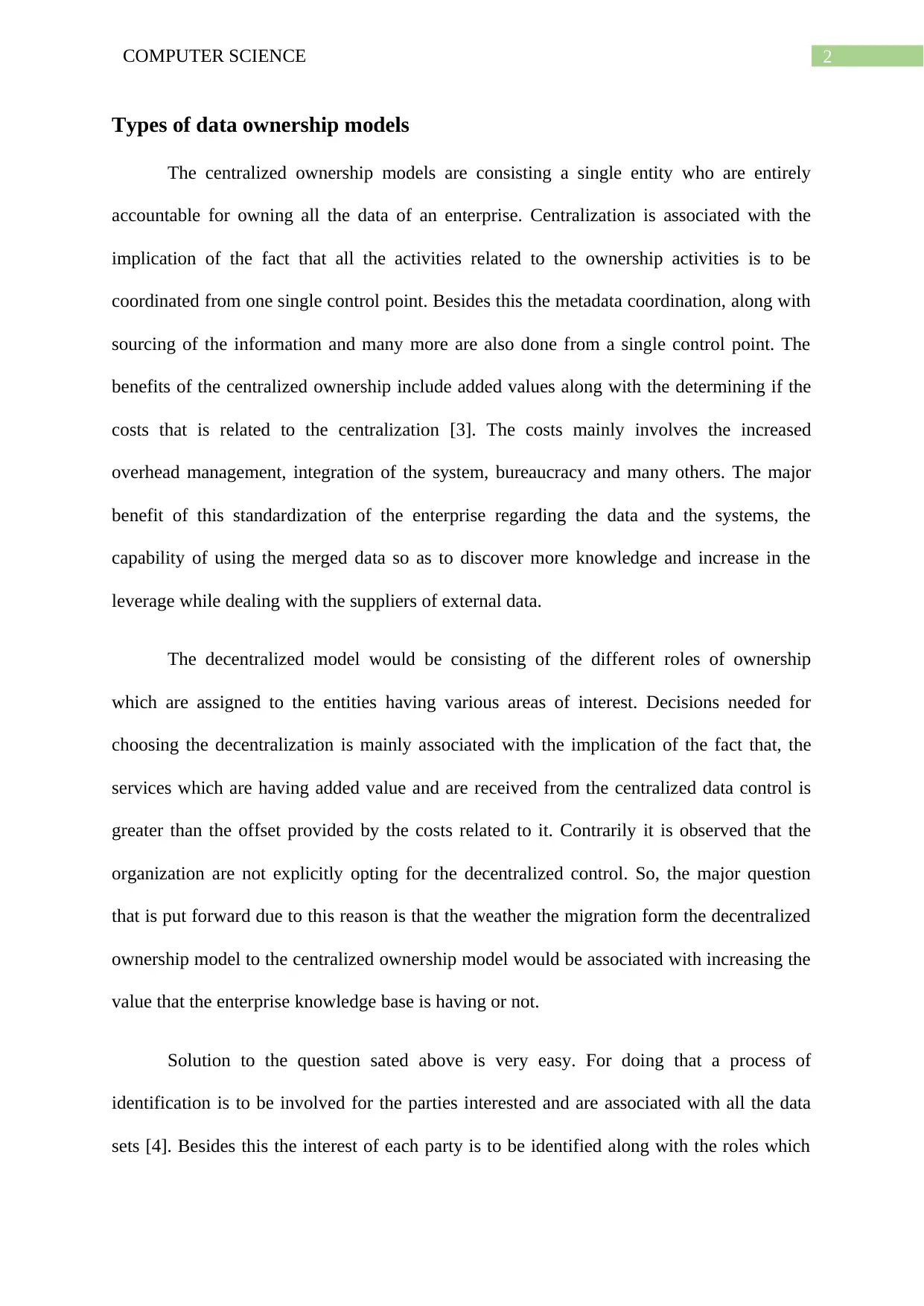
2COMPUTER SCIENCE
Types of data ownership models
The centralized ownership models are consisting a single entity who are entirely
accountable for owning all the data of an enterprise. Centralization is associated with the
implication of the fact that all the activities related to the ownership activities is to be
coordinated from one single control point. Besides this the metadata coordination, along with
sourcing of the information and many more are also done from a single control point. The
benefits of the centralized ownership include added values along with the determining if the
costs that is related to the centralization [3]. The costs mainly involves the increased
overhead management, integration of the system, bureaucracy and many others. The major
benefit of this standardization of the enterprise regarding the data and the systems, the
capability of using the merged data so as to discover more knowledge and increase in the
leverage while dealing with the suppliers of external data.
The decentralized model would be consisting of the different roles of ownership
which are assigned to the entities having various areas of interest. Decisions needed for
choosing the decentralization is mainly associated with the implication of the fact that, the
services which are having added value and are received from the centralized data control is
greater than the offset provided by the costs related to it. Contrarily it is observed that the
organization are not explicitly opting for the decentralized control. So, the major question
that is put forward due to this reason is that the weather the migration form the decentralized
ownership model to the centralized ownership model would be associated with increasing the
value that the enterprise knowledge base is having or not.
Solution to the question sated above is very easy. For doing that a process of
identification is to be involved for the parties interested and are associated with all the data
sets [4]. Besides this the interest of each party is to be identified along with the roles which
Types of data ownership models
The centralized ownership models are consisting a single entity who are entirely
accountable for owning all the data of an enterprise. Centralization is associated with the
implication of the fact that all the activities related to the ownership activities is to be
coordinated from one single control point. Besides this the metadata coordination, along with
sourcing of the information and many more are also done from a single control point. The
benefits of the centralized ownership include added values along with the determining if the
costs that is related to the centralization [3]. The costs mainly involves the increased
overhead management, integration of the system, bureaucracy and many others. The major
benefit of this standardization of the enterprise regarding the data and the systems, the
capability of using the merged data so as to discover more knowledge and increase in the
leverage while dealing with the suppliers of external data.
The decentralized model would be consisting of the different roles of ownership
which are assigned to the entities having various areas of interest. Decisions needed for
choosing the decentralization is mainly associated with the implication of the fact that, the
services which are having added value and are received from the centralized data control is
greater than the offset provided by the costs related to it. Contrarily it is observed that the
organization are not explicitly opting for the decentralized control. So, the major question
that is put forward due to this reason is that the weather the migration form the decentralized
ownership model to the centralized ownership model would be associated with increasing the
value that the enterprise knowledge base is having or not.
Solution to the question sated above is very easy. For doing that a process of
identification is to be involved for the parties interested and are associated with all the data
sets [4]. Besides this the interest of each party is to be identified along with the roles which
⊘ This is a preview!⊘
Do you want full access?
Subscribe today to unlock all pages.

Trusted by 1+ million students worldwide
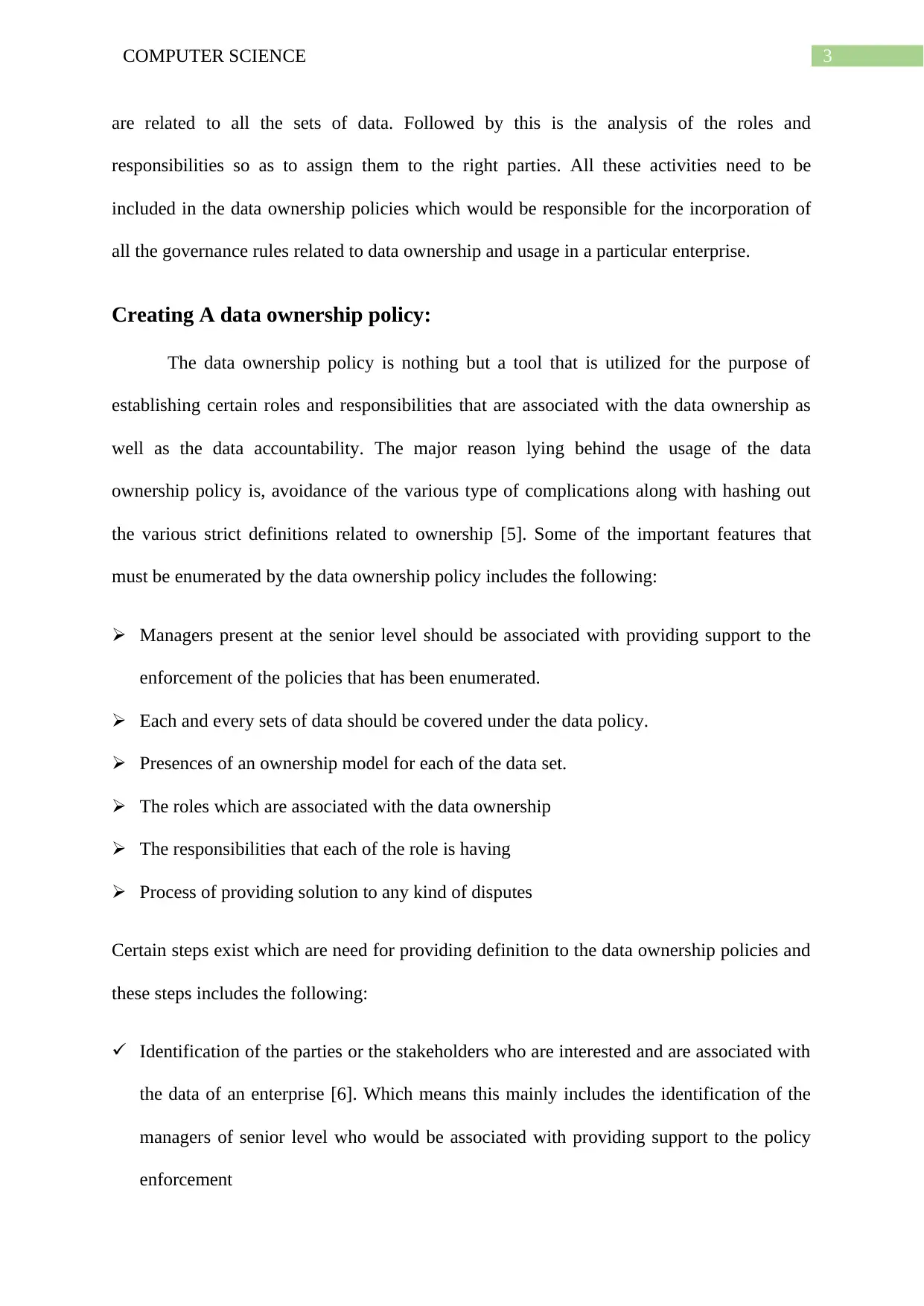
3COMPUTER SCIENCE
are related to all the sets of data. Followed by this is the analysis of the roles and
responsibilities so as to assign them to the right parties. All these activities need to be
included in the data ownership policies which would be responsible for the incorporation of
all the governance rules related to data ownership and usage in a particular enterprise.
Creating A data ownership policy:
The data ownership policy is nothing but a tool that is utilized for the purpose of
establishing certain roles and responsibilities that are associated with the data ownership as
well as the data accountability. The major reason lying behind the usage of the data
ownership policy is, avoidance of the various type of complications along with hashing out
the various strict definitions related to ownership [5]. Some of the important features that
must be enumerated by the data ownership policy includes the following:
Managers present at the senior level should be associated with providing support to the
enforcement of the policies that has been enumerated.
Each and every sets of data should be covered under the data policy.
Presences of an ownership model for each of the data set.
The roles which are associated with the data ownership
The responsibilities that each of the role is having
Process of providing solution to any kind of disputes
Certain steps exist which are need for providing definition to the data ownership policies and
these steps includes the following:
Identification of the parties or the stakeholders who are interested and are associated with
the data of an enterprise [6]. Which means this mainly includes the identification of the
managers of senior level who would be associated with providing support to the policy
enforcement
are related to all the sets of data. Followed by this is the analysis of the roles and
responsibilities so as to assign them to the right parties. All these activities need to be
included in the data ownership policies which would be responsible for the incorporation of
all the governance rules related to data ownership and usage in a particular enterprise.
Creating A data ownership policy:
The data ownership policy is nothing but a tool that is utilized for the purpose of
establishing certain roles and responsibilities that are associated with the data ownership as
well as the data accountability. The major reason lying behind the usage of the data
ownership policy is, avoidance of the various type of complications along with hashing out
the various strict definitions related to ownership [5]. Some of the important features that
must be enumerated by the data ownership policy includes the following:
Managers present at the senior level should be associated with providing support to the
enforcement of the policies that has been enumerated.
Each and every sets of data should be covered under the data policy.
Presences of an ownership model for each of the data set.
The roles which are associated with the data ownership
The responsibilities that each of the role is having
Process of providing solution to any kind of disputes
Certain steps exist which are need for providing definition to the data ownership policies and
these steps includes the following:
Identification of the parties or the stakeholders who are interested and are associated with
the data of an enterprise [6]. Which means this mainly includes the identification of the
managers of senior level who would be associated with providing support to the policy
enforcement
Paraphrase This Document
Need a fresh take? Get an instant paraphrase of this document with our AI Paraphraser
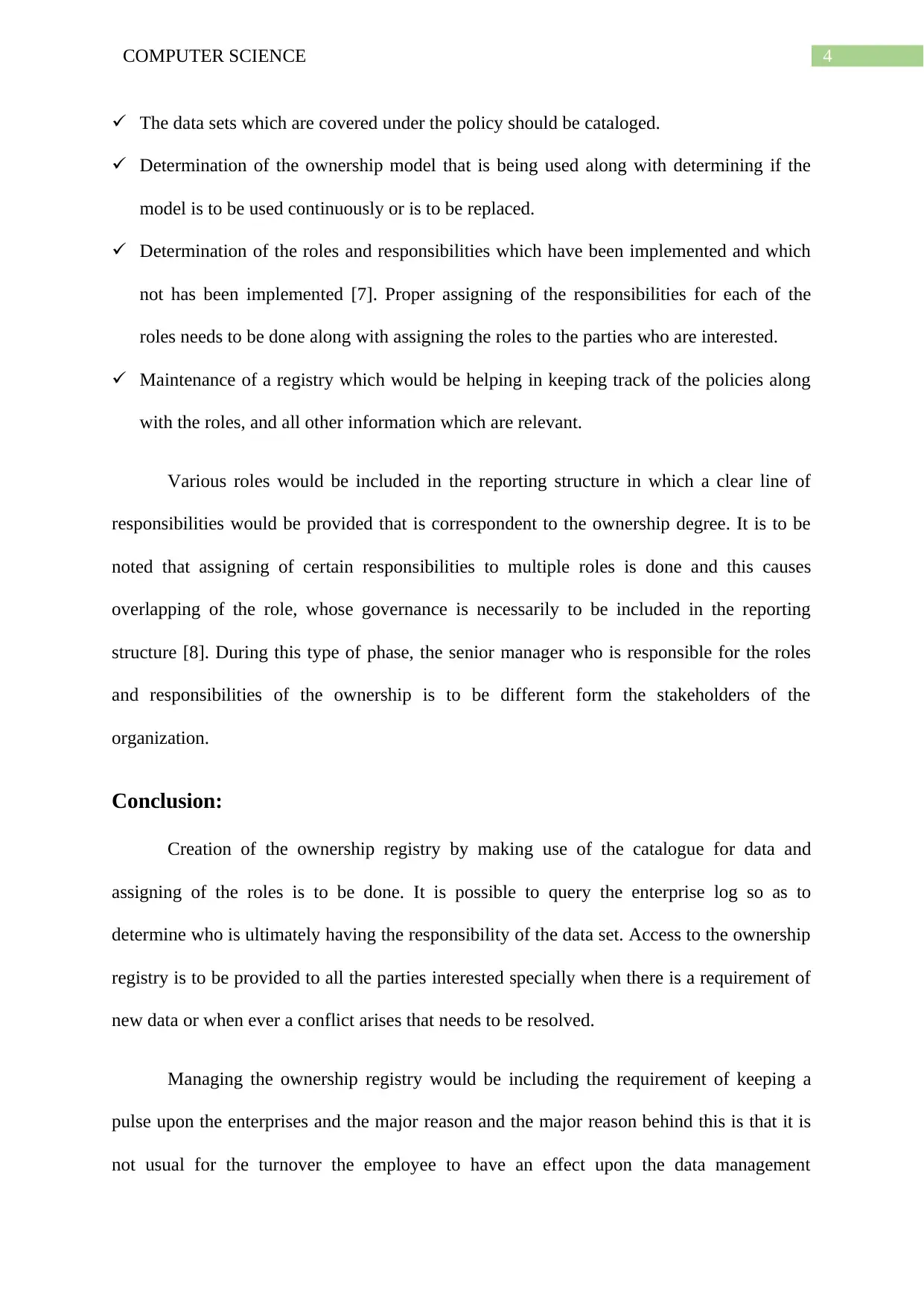
4COMPUTER SCIENCE
The data sets which are covered under the policy should be cataloged.
Determination of the ownership model that is being used along with determining if the
model is to be used continuously or is to be replaced.
Determination of the roles and responsibilities which have been implemented and which
not has been implemented [7]. Proper assigning of the responsibilities for each of the
roles needs to be done along with assigning the roles to the parties who are interested.
Maintenance of a registry which would be helping in keeping track of the policies along
with the roles, and all other information which are relevant.
Various roles would be included in the reporting structure in which a clear line of
responsibilities would be provided that is correspondent to the ownership degree. It is to be
noted that assigning of certain responsibilities to multiple roles is done and this causes
overlapping of the role, whose governance is necessarily to be included in the reporting
structure [8]. During this type of phase, the senior manager who is responsible for the roles
and responsibilities of the ownership is to be different form the stakeholders of the
organization.
Conclusion:
Creation of the ownership registry by making use of the catalogue for data and
assigning of the roles is to be done. It is possible to query the enterprise log so as to
determine who is ultimately having the responsibility of the data set. Access to the ownership
registry is to be provided to all the parties interested specially when there is a requirement of
new data or when ever a conflict arises that needs to be resolved.
Managing the ownership registry would be including the requirement of keeping a
pulse upon the enterprises and the major reason and the major reason behind this is that it is
not usual for the turnover the employee to have an effect upon the data management
The data sets which are covered under the policy should be cataloged.
Determination of the ownership model that is being used along with determining if the
model is to be used continuously or is to be replaced.
Determination of the roles and responsibilities which have been implemented and which
not has been implemented [7]. Proper assigning of the responsibilities for each of the
roles needs to be done along with assigning the roles to the parties who are interested.
Maintenance of a registry which would be helping in keeping track of the policies along
with the roles, and all other information which are relevant.
Various roles would be included in the reporting structure in which a clear line of
responsibilities would be provided that is correspondent to the ownership degree. It is to be
noted that assigning of certain responsibilities to multiple roles is done and this causes
overlapping of the role, whose governance is necessarily to be included in the reporting
structure [8]. During this type of phase, the senior manager who is responsible for the roles
and responsibilities of the ownership is to be different form the stakeholders of the
organization.
Conclusion:
Creation of the ownership registry by making use of the catalogue for data and
assigning of the roles is to be done. It is possible to query the enterprise log so as to
determine who is ultimately having the responsibility of the data set. Access to the ownership
registry is to be provided to all the parties interested specially when there is a requirement of
new data or when ever a conflict arises that needs to be resolved.
Managing the ownership registry would be including the requirement of keeping a
pulse upon the enterprises and the major reason and the major reason behind this is that it is
not usual for the turnover the employee to have an effect upon the data management
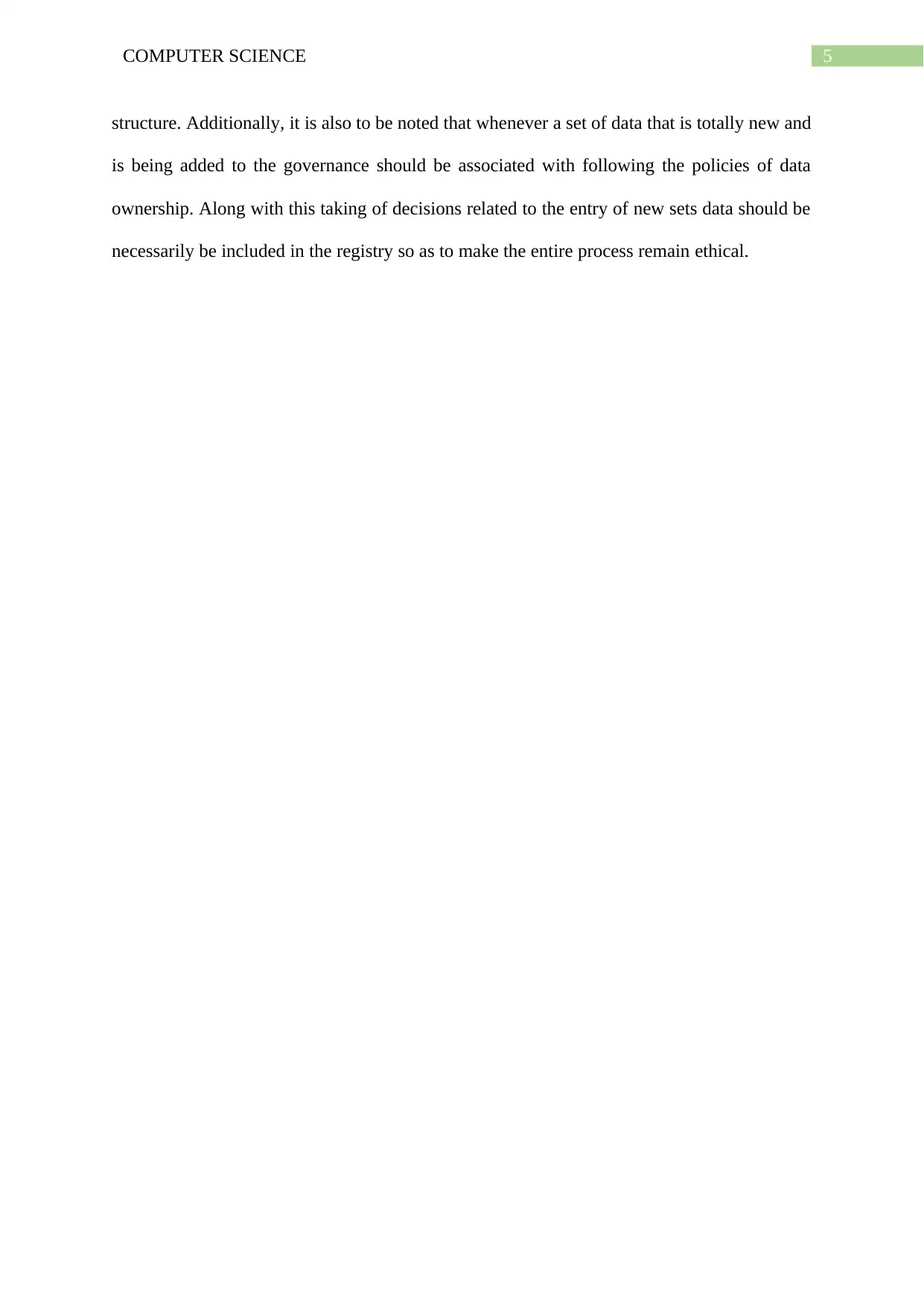
5COMPUTER SCIENCE
structure. Additionally, it is also to be noted that whenever a set of data that is totally new and
is being added to the governance should be associated with following the policies of data
ownership. Along with this taking of decisions related to the entry of new sets data should be
necessarily be included in the registry so as to make the entire process remain ethical.
structure. Additionally, it is also to be noted that whenever a set of data that is totally new and
is being added to the governance should be associated with following the policies of data
ownership. Along with this taking of decisions related to the entry of new sets data should be
necessarily be included in the registry so as to make the entire process remain ethical.
⊘ This is a preview!⊘
Do you want full access?
Subscribe today to unlock all pages.

Trusted by 1+ million students worldwide
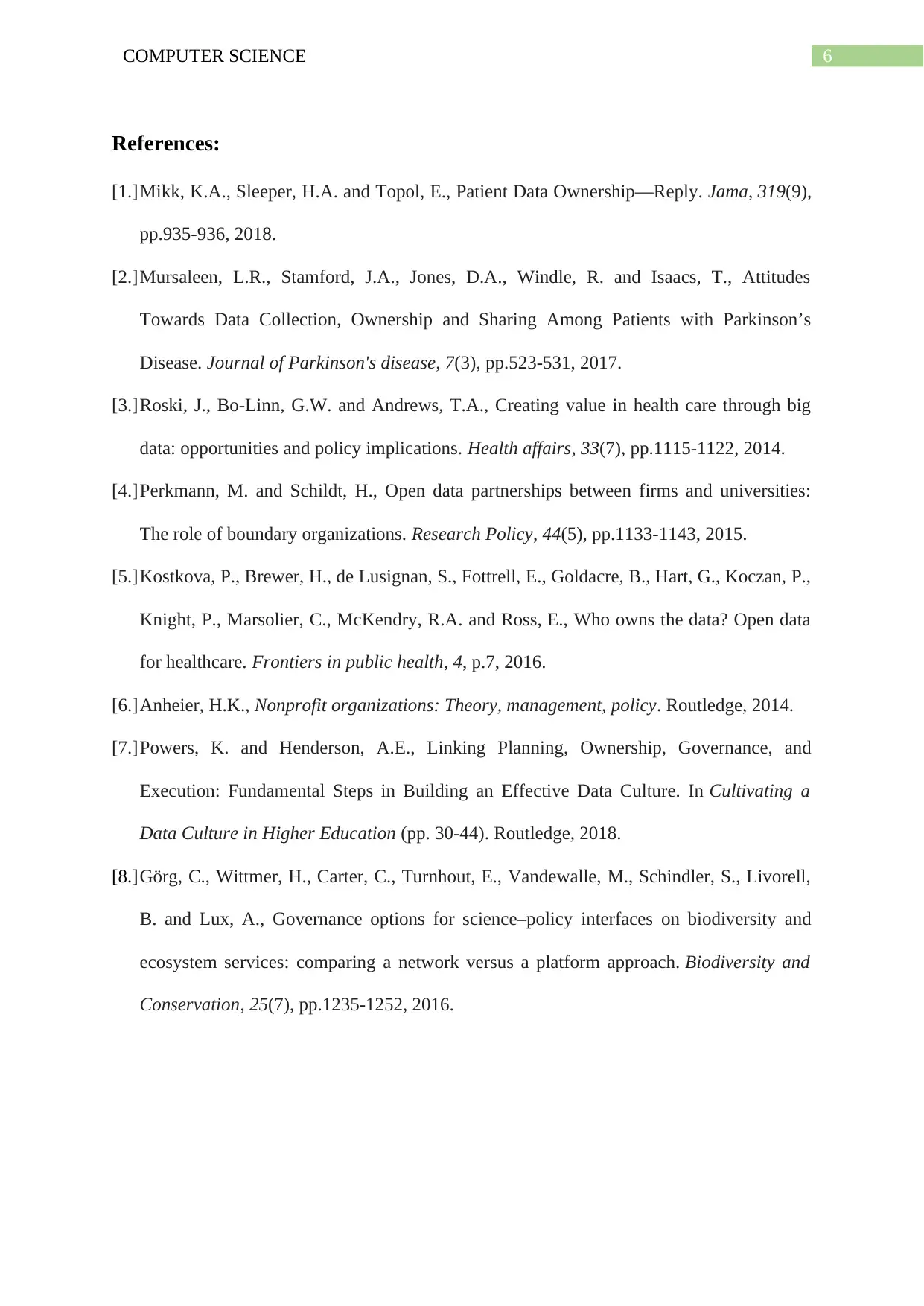
6COMPUTER SCIENCE
References:
[1.]Mikk, K.A., Sleeper, H.A. and Topol, E., Patient Data Ownership—Reply. Jama, 319(9),
pp.935-936, 2018.
[2.]Mursaleen, L.R., Stamford, J.A., Jones, D.A., Windle, R. and Isaacs, T., Attitudes
Towards Data Collection, Ownership and Sharing Among Patients with Parkinson’s
Disease. Journal of Parkinson's disease, 7(3), pp.523-531, 2017.
[3.]Roski, J., Bo-Linn, G.W. and Andrews, T.A., Creating value in health care through big
data: opportunities and policy implications. Health affairs, 33(7), pp.1115-1122, 2014.
[4.]Perkmann, M. and Schildt, H., Open data partnerships between firms and universities:
The role of boundary organizations. Research Policy, 44(5), pp.1133-1143, 2015.
[5.]Kostkova, P., Brewer, H., de Lusignan, S., Fottrell, E., Goldacre, B., Hart, G., Koczan, P.,
Knight, P., Marsolier, C., McKendry, R.A. and Ross, E., Who owns the data? Open data
for healthcare. Frontiers in public health, 4, p.7, 2016.
[6.]Anheier, H.K., Nonprofit organizations: Theory, management, policy. Routledge, 2014.
[7.]Powers, K. and Henderson, A.E., Linking Planning, Ownership, Governance, and
Execution: Fundamental Steps in Building an Effective Data Culture. In Cultivating a
Data Culture in Higher Education (pp. 30-44). Routledge, 2018.
[8.]Görg, C., Wittmer, H., Carter, C., Turnhout, E., Vandewalle, M., Schindler, S., Livorell,
B. and Lux, A., Governance options for science–policy interfaces on biodiversity and
ecosystem services: comparing a network versus a platform approach. Biodiversity and
Conservation, 25(7), pp.1235-1252, 2016.
References:
[1.]Mikk, K.A., Sleeper, H.A. and Topol, E., Patient Data Ownership—Reply. Jama, 319(9),
pp.935-936, 2018.
[2.]Mursaleen, L.R., Stamford, J.A., Jones, D.A., Windle, R. and Isaacs, T., Attitudes
Towards Data Collection, Ownership and Sharing Among Patients with Parkinson’s
Disease. Journal of Parkinson's disease, 7(3), pp.523-531, 2017.
[3.]Roski, J., Bo-Linn, G.W. and Andrews, T.A., Creating value in health care through big
data: opportunities and policy implications. Health affairs, 33(7), pp.1115-1122, 2014.
[4.]Perkmann, M. and Schildt, H., Open data partnerships between firms and universities:
The role of boundary organizations. Research Policy, 44(5), pp.1133-1143, 2015.
[5.]Kostkova, P., Brewer, H., de Lusignan, S., Fottrell, E., Goldacre, B., Hart, G., Koczan, P.,
Knight, P., Marsolier, C., McKendry, R.A. and Ross, E., Who owns the data? Open data
for healthcare. Frontiers in public health, 4, p.7, 2016.
[6.]Anheier, H.K., Nonprofit organizations: Theory, management, policy. Routledge, 2014.
[7.]Powers, K. and Henderson, A.E., Linking Planning, Ownership, Governance, and
Execution: Fundamental Steps in Building an Effective Data Culture. In Cultivating a
Data Culture in Higher Education (pp. 30-44). Routledge, 2018.
[8.]Görg, C., Wittmer, H., Carter, C., Turnhout, E., Vandewalle, M., Schindler, S., Livorell,
B. and Lux, A., Governance options for science–policy interfaces on biodiversity and
ecosystem services: comparing a network versus a platform approach. Biodiversity and
Conservation, 25(7), pp.1235-1252, 2016.
1 out of 7
Related Documents
Your All-in-One AI-Powered Toolkit for Academic Success.
+13062052269
info@desklib.com
Available 24*7 on WhatsApp / Email
![[object Object]](/_next/static/media/star-bottom.7253800d.svg)
Unlock your academic potential
Copyright © 2020–2025 A2Z Services. All Rights Reserved. Developed and managed by ZUCOL.





